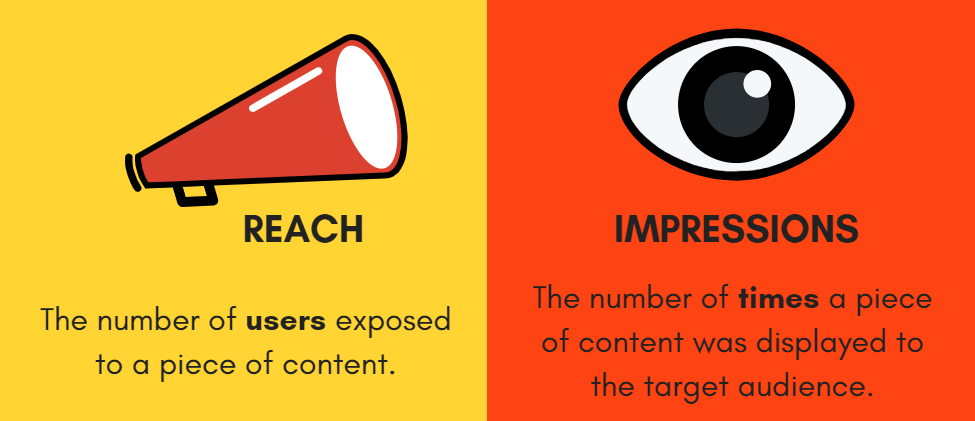The Difference Between Social Media Reach and Impressions
Reputation Staff Writer

If you’re trying to increase your visibility and influence on social media, then the terms reach and impressions will sound very familiar. If you’re a marketer, you likely understand the difference between the two metrics, however you might still need a refresher when it comes to establishing which is key for your social media goals.
Whether you’re assessing your current campaign strategy or optimizing your overall visibility and engagement reach and impressions can help you monitor your progress. These are two metrics you can easily monitor in your social media listening and monitoring strategies.
What are Impressions?
Generally speaking, impressions refer to the total number of times your social media ad or content has been displayed, regardless of whether or not it was clicked. A viewer doesn’t need to engage with a post to be referred to as an impression since it is not measured. Impressions are always higher than reach, as one person can have multiple impressions for a single piece of content.

Source: Keyhole
What is Reach?
Reach is the total number of people who were exposed to your ad or content. If 50 people saw your content, then that content’s reach was 50. However, unfortunately, if you have 50 followers, that does not mean all 50 will engage with your content. That’s because popular social media sites use complex algorithms that determine who to show content to and when.
Reach vs. Impressions: What’s the Difference?
Reach and impressions mean different things on different social platforms. However, they are two separate concepts and should not be used interchangeably. To understand the difference between reach and impressions, consider impressions as the number of times your content is displayed to your users and reach the total number of users who have viewed your content.
Related: A Quick Guide to Getting a Blue Checkmark on Instagram
Reach vs. Impressions: Which is More Important?
Now with a basic understanding of reach vs. impressions, it’s time to understand which is more important. Unfortunately, there is no clear answer as it depends on your social listening or monitoring goals. For example, if your strategy is to track your ads on a moment-to-moment basis, your focus should be on media impressions, as the metric can gauge how your users are responding to your ads.
Having your social media manager on reach can tell you if there is something wrong with your ads that your team should reassess. For example, if your ads reach a lot of users but fail to increase conversions, then you may need to consider changing your the photos, videos, or blog posts you share.
Or, you should reconsider who you’re trying to reach and alter your approach accordingly. That can likely help to boost the customer experience and encourage your target audience to join the conversation surrounding your brand online.
Instagram Reach vs. Impressions
Instagram defines reach as the unique number of users who have viewed your post or story and impressions as the number of times a story or post has been displayed. To track the progress of reach vs. impressions on Instagram, click ‘view insights’ under one of your posts, or swipe up the story for which you intend to view analytics.
Once accessed, you will be able to analyze your Instagram impressions vs. reach. Your impressions are also available in the broken-down subcategories of hashtags, profile, and explore. As a bonus, you can also see what percentage of users your content has reached who are not followers.
Facebook Reach vs. Impressions
Facebook defines reach and impressions similarly to Instagram. However, the Facebook app organizes reach into three categories:
- Organic: The number of unique users who viewed your content in their news feed.
- Paid: The number of users who saw paid content on their Facebook newsfeed.
- Viral: The number of users who saw your content because it was mentioned in a story or post published by a friend. This includes liking, sharing, or commenting on a post.
Related: The Facebook Outage: How to Manage a Large Scale Crisis
Just like reach, impressions are also broken down into three categories:
- Organic: The number of times your content was displayed, for free, on your personal page or news feed.
- Paid: The number of times your paid content was displayed on a user’s newsfeed.
- Viral: The number of times content was seen because one of their friends interacted with it.
Twitter Reach vs. Impressions
Keep in mind that Twitter works a little differently than other types of social media platforms. It doesn’t measure your reach but does track your impressions. Twitter defines impressions as anytime a user sees your tweet.
Impressions show your tweets’ views or the number of times your content has popped up on another active user’s feed, in search results, or to another user’s followers. Twitter is like a built-in analytics tool — take advantage of that and use that data to inform your social media marketing efforts.
How Reputation Can Help You With Social Media
It’s crucial to understand these two social metric terms and decide which is essential to your social media strategy goals. At Reputation, we offer social media software allowing you to take control of your social media channels. Implement content seamlessly across social networking sites, analyze social data, and connect with your followers in innovative ways. With our tools, you’ll receive contextual insights businesses need to engage with their customers and communities meaningfully.
We specialize in online reputation management and can help you transform your brand’s image. Discover how the Reputation platform can give you the tools you need to take your business to the next level.
Keep Reading: Social Listening & Social Monitoring: What’s the Difference?

